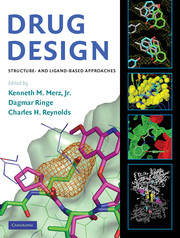Book contents
- Frontmatter
- Contents
- Contributors
- Preface
- DRUG DESIGN
- 1 Progress and issues for computationally guided lead discovery and optimization
- PART I STRUCTURAL BIOLOGY
- PART II COMPUTATIONAL CHEMISTRY METHODOLOGY
- 5 Free-energy calculations in structure-based drug design
- 6 Studies of drug resistance and the dynamic behavior of HIV-1 protease through molecular dynamics simulations
- 7 Docking: a domesday report
- 8 The role of quantum mechanics in structure-based drug design
- 9 Pharmacophore methods
- 10 QSAR in drug discovery
- 11 Predicting ADME properties in drug discovery
- PART III APPLICATIONS TO DRUG DISCOVERY
- Index
- References
5 - Free-energy calculations in structure-based drug design
from PART II - COMPUTATIONAL CHEMISTRY METHODOLOGY
Published online by Cambridge University Press: 06 July 2010
- Frontmatter
- Contents
- Contributors
- Preface
- DRUG DESIGN
- 1 Progress and issues for computationally guided lead discovery and optimization
- PART I STRUCTURAL BIOLOGY
- PART II COMPUTATIONAL CHEMISTRY METHODOLOGY
- 5 Free-energy calculations in structure-based drug design
- 6 Studies of drug resistance and the dynamic behavior of HIV-1 protease through molecular dynamics simulations
- 7 Docking: a domesday report
- 8 The role of quantum mechanics in structure-based drug design
- 9 Pharmacophore methods
- 10 QSAR in drug discovery
- 11 Predicting ADME properties in drug discovery
- PART III APPLICATIONS TO DRUG DISCOVERY
- Index
- References
Summary
INTRODUCTION
The ultimate goal of structure-based drug design is a simple, robust process that starts with a high-resolution crystal structure of a validated biological macromolecular target and reliably generates an easily synthesized, high-affinity small molecule with desirable pharmacological properties. Although pharmaceutical science has made significant gains in understanding how to generate, test, and validate small molecules for specific biochemical activity, such a complete process does not now exist. In any drug design project, enormous amounts of luck, intuition, and trial and error are still necessary.
For any small molecule to be considered a likely drug candidate, it must satisfy a number of different absorption/distribution/metabolism/excretion (ADME) properties and have a good toxicological profile. However, a small molecule must above all be active, which in most cases means that it must bind tightly and selectively to a specific location in the protein target before any of the other important characteristics are relevant. To design a drug, large regions of chemical space must be explored to find candidate molecules with the desired biological activity. High-throughput experimental screening methods have become the workhorse for finding such hits. However, their results are limited by the quality and diversity of the preexisting chemical libraries, which may contain only molecules representative of a limited portion of the relevant chemical space for a given target. Combinatorial libraries can be produced to supplement these efforts, but their use requires careful design strategies and they are subject to a number of pitfalls.
- Type
- Chapter
- Information
- Drug DesignStructure- and Ligand-Based Approaches, pp. 61 - 86Publisher: Cambridge University PressPrint publication year: 2010
References
- 55
- Cited by



